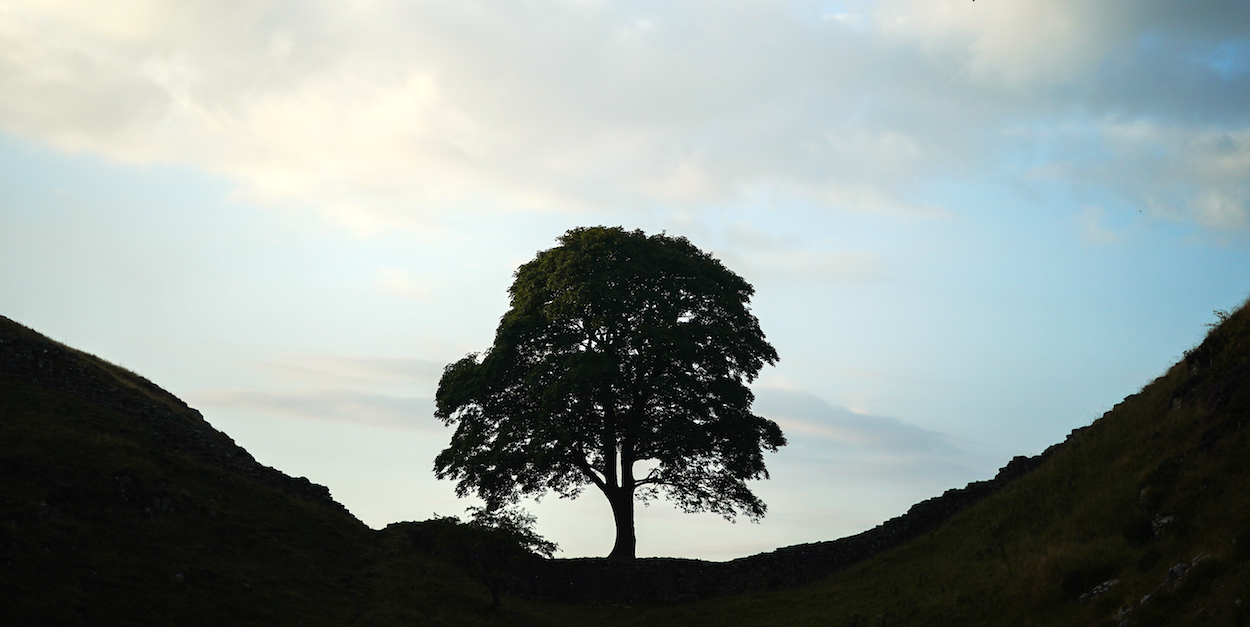I don’t know about you, but my reaction to learning about the felling of that tree in Northumberland was, well, weird. For a start, unlike many others, I’ve never hugged this lovely tree, never picnicked beneath it, never proposed next to it, never seen it after a long satisfying hike along Hadrian’s Wall, so I do not have much personal connection.
In fact, I’ve never even been there. My only knowledge of the sycamore gap sycamore is seeing it in the Hollywood movie, Robin Hood: Prince of Thieves, which in turn – along with some later, pretty images of snowbound hills and auroral lights – slowly induced this extremely vague sense that up there, in far northern England, there was this splendid tree that one day I might visit, maybe, who knows.
I mean, it is just a tree. That I saw in a film. Never in the flesh or the bark. And yet, when I learned from social media that it had been felled, I felt distinctly sick. Like some terrible moral error had been made, as though some lovable, smiley person from my local shops had been shot. Nor was I alone in this nausea, I know people – who have never physically encountered that tree – who literally cried when they heard the news and saw the horrible photos.
Why and how are we reacting like this? It’s a good question, and one I have already heard: I have friends who are chastising me for my over-emotional reaction to the felling of The Tree. They mention the Londoners who have died recently and they ask me why I don’t similarly grieve for them; they talk about eco-lunatic sentimentality – and scorn my pitiable sadness; they speak of logic and balance and all that. Nonetheless, here I am feeling abject, and reaching for poetry to console me, specifically Gerard Manley Hopkins, who wrote one of the finer verses in English – Binsey Poplars – after seeing a stand of beloved trees chopped down in 1879. This is one section of that poem:
O if we but knew what we do
When we delve or hew –
Hack and rack the growing green!
Since country is so tender
To touch, her being só slender,
That, like this sleek and seeing ball
But a prick will make no eye at all,
Where we, even where we mean
To mend her we end her,
When we hew or delve:
After-comers cannot guess the beauty been.
Reading that poem, and I have read it several times since learning of the fate of the Northumberland sycamore, gives me some solace. It teaches me that great art and serious beauty can be born out of destruction. But it does not explain why I am so gutted about a tree I never even met.
Perhaps I am just pathetically decadent, caring more for greenery than humanity. Perhaps I am an idiot seduced by the hysteria of Twitter and TikTok. Perhaps all that is true, but even if it is, I believe there are two further explanations: one nesting inside the other.
Firstly, that tree was one of the most famous in the country, partly thanks to Hollywood. Also, it is – was – a noble living thing in a unique historic location and revered by tens of thousands who have visited it, in real life, and others like me who have seen it on screens.
In that context, it was the organic equivalent of, say, a great Gothic cathedral. And the wanton, pointless destruction of something like that is extremely rare, compared to quotidian sins. Homicides are unbearably awful, homicides of young people are even worse, and yet, tragically, they are also commonplace – to outsiders. Thus, the felling of The Tree is different, because the ancient tree was renowned and sacred, like a marvellous church, or a circle of stones. People don’t knock over York Minster every day. Therefore, when they do, the agony is profound, universal, and visceral.
Beyond that, I reckon something wider is at work. The anguish we express over the sycamore gap sycamore stems from our feelings of shame at what we have done to Mother Nature. We all feel this, constantly and in various ways, like a melancholic background vibration in our lives. But seldom is it focused and crystalised into one event like this.
And that is why the felling affects us so deeply. We are grieving for all the creatures and landscapes we have hurt, emblematised by one beloved tree, now dead in a field in Northumberland. We mourn for our long-lost innocence and we burden this singular crime with our shared, intolerable guilt. And after-comers cannot guess the beauty been.






Comments